
Background information
Full array local dimming: almost as good as OLED?
by Luca Fontana

OLED fights against QLED, and in the end no one comes out ahead. Letter dramas deliberately cause confusion. For consumers, such marketing trench warfare can only be won through information.
OLED and QLED. Sometimes a small line makes the difference. In this case, the line is in the "O". You will come across the two terms at the latest when you are thinking about buying a new TV. Because there's a marketing trench war going on at the moment.
What's it all about?
OLED is a TV technology that is not completely new, but has dominated the TV market in the upper price segment for a year or two. The name QLED is a marketing term, but the technology itself is a further development of LCD technology that is intended to give the OLED faction a run for its money.
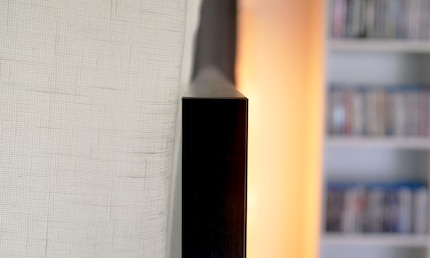
Every screen consists of pixels that are arranged like squares on a chessboard - the pixel grid. The number of pixels within the grid determines the resolution. Ultra HD televisions have slightly more than eight million pixels, expressed in the number of pixels per width times pixels per height: 3840 × 2160 pixels.
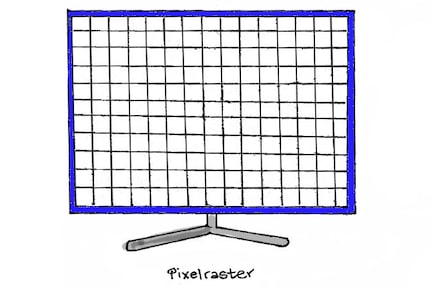
What you see as a homogeneous TV picture is actually a highly complex interplay of millions of pixels. Depending on how bright or dark each individual pixel shines, and with which colour, you get an image in which the individual pixel can no longer be distinguished from the others.
Screen technologies are therefore primarily concerned with the following questions:
LCD technology is named after the "liquid crystals" that create the image - in other words, the liquid crystals. The light that makes the pixels glow comes from LED backlighting. The diodes are not only much smaller than the white fluorescent tubes used in the past, but also emit cleaner light. Special plastic foils between the LEDs and the LCD panel distribute the light evenly across the screen surface.
Once the LED light has been distributed by the plastic film, it hits the pixels from behind. Each pixel consists of three further pixels - the subpixels. With eight million pixels, this makes around 24 million subpixels, which sit close together on an area of 145 × 83 centimetres on a 65-inch television.
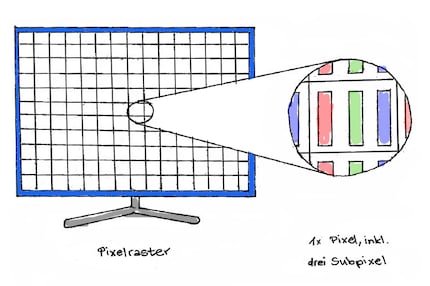
Each subpixel represents a basic colour: Red, green or blue. The colour of the entire pixel is determined by how its three subpixels are mixed. For example, if red, green and blue are fully illuminated at the same time, you perceive a white pixel.
The colour of the pixel is not only determined by the mixing of the sub-pixels. It also depends on how brightly they light up. Along the lines of: if you mix a dark red with a dark blue, you get a different violet colour than if you mix a light red with a light blue.
So how is the brightness of the sub-pixels influenced? This is done by the liquid crystals located in front of the colour filters. Put simply, the crystals have the ability to block incoming light or allow it to pass through. This works together with a little electrical voltage and the two polarisation filters.
QLED TVs are basically LCD televisions. In other words: LED light hits a plastic film. This distributes the light evenly across the screen. Liquid crystals then control how much light is allowed to pass through. Finally, the subpixels colour the light.
But LCD screens have a problem: red and green are not displayed cleanly; the image always has a slight blue tint. This is due to the LEDs, which initially produce blue light. Together with a yellowish phosphor layer in front of the LEDs, they produce white light. It is later coloured by the red, green and blue subpixels.
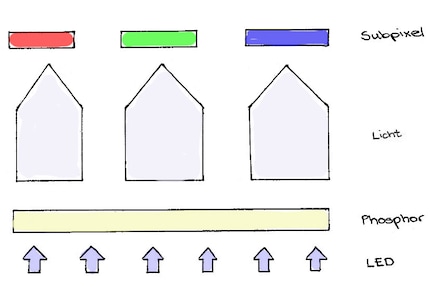
This white light is not one hundred per cent white. Small impurities remain, the colours do not appear as strong as they could be if the light were purer. And then there is the blue tint of the LEDs.


QLED televisions correct this impurity as far as possible. They use quantum dots - tiny nanoparticles - which are located inside the plastic film in front of the LEDs. They absorb the blue light and then - depending on the oscillation - emit coloured light themselves.
Imagine the Quantum Dots as a pendulum on a string. When light hits quantum dots pendulums, they start to oscillate. The larger the pendulum, the heavier it is. The heavier the pendulum, the slower it swings.
These oscillations are actually electromagnetic waves. They determine the colour of light for the human eye: Small oscillations produce blue light, while large oscillations produce red light. And somewhere in between, the light vibrates green.
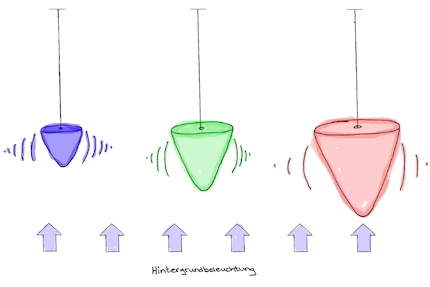
A quick reminder: When red, green and blue subpixels emit light at the same time, they produce "white" for the human eye. The same happens with LEDs and quantum dots. When the blue light hits nanoparticles, which emit deep red or rich green light depending on their size, they produce white light that is much brighter and purer than that of LCD televisions with their phosphor layers.
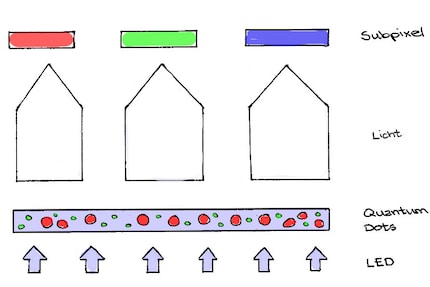
From this purer basic white, the subpixels can mix many more intermediate tones than conventional LCD panels. In addition, more light reaches the viewer because the LCD panel is spared tedious filter work. This combination of a wider colour palette and greater luminosity ensures colours with significantly improved contrast values. This is important to support High Dynamic Range (HDR).
OLED screens have long been regarded as the technology of the future. The first prototypes could be seen at trade fairs such as IFA in Berlin around ten years ago. They have been affordable but expensive for a few years now. However, according to the majority of experts, they deliver the best picture you can get for the money. OLED TV panels are manufactured by LG Display, which has a monopoly on this technology.
What does OLED mean? The term is derived from the organic origin of the LEDs in the TV panel. Unlike conventional LEDs, OLEDs can be made so small that they are not only a light source but also a pixel. Technically speaking, carbon compounds interact with organic colour molecules and electrical impulses to produce light.
An OLED pixel also consists of several sub-pixels. In contrast to LCD televisions, however, four rather than three subpixels are used.
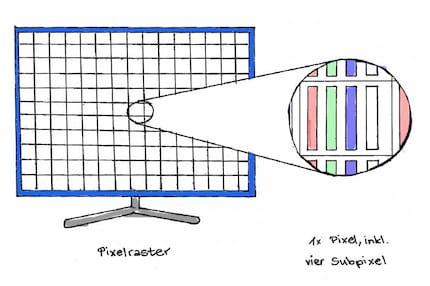
At first, all subpixels glow white. The white is created by a kind of "RGB OLED sandwich". An overlying colour filter determines which parts of white are visible - red, green or blue. Only the fourth subpixel has no filter and passes on its white light unfiltered. This not only improves the brightness values of the screen, it also enables more colour mixing.
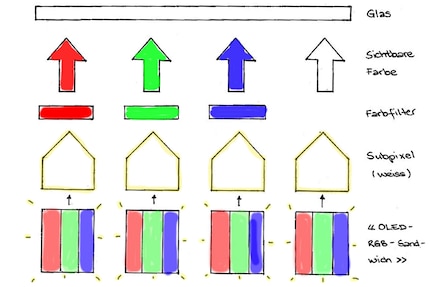
At first glance, this seems unnecessarily complicated. If the panel already uses red, green or blue OLEDs, why not simply make red, green or blue subpixels and dispense with the colour filters?
Earlier OLED generations used subpixels that have their own colour. Because the blue, organic subpixels aged too quickly, they lost their luminosity. And the red and green subpixels alone make decent colour reproduction impossible.
The four white sub-pixels solve the problem of different ageing: Because they all have the same, white "colour", they are stressed evenly. OLED televisions therefore become darker over time. It takes around ten to fifteen years before you notice this, but the colour reproduction remains consistent.

OLEDs are celebrated because the colour reproduction looks natural, but not abnormally bright. This is not only due to their ability to display the deepest blacks, but also to the excellent contrast values.
Contrast describes how big the difference is between the darkest and the brightest pixel. The greater this difference, the more gradations of brightness there can be. This means that more colours can be displayed. And more colours make for a better and more natural image.

The above is an example of a small contrast ratio. The number of brightness levels per colour is small. Correspondingly few colours can be mixed.
Below is an example of a high contrast ratio. There are so many brightness levels that the transitions can no longer be seen by the eye. Millions of colours can be mixed from this.

OLED televisions not only have a high contrast ratio, but also an extremely wide contrast range: the difference between black and white is particularly large. Because OLED pixels light up automatically, they can switch off when required. This creates true black and is something so extraordinary that the industry has coined the term "true black" for it.
LCD pixels cannot produce true black. They are physically incapable of it. Their liquid crystals theoretically seal off the light in black, but in practice something still gets through. The result is a grey haze.
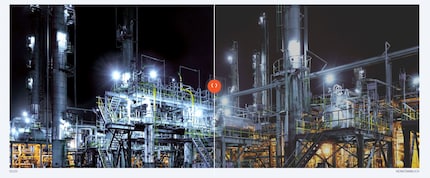
For similarly good contrast values, LCD screens do something other than widen the range towards dark black: they widen the range in the opposite direction and counter with a brighter white. This is because the inorganic LEDs can shine brighter than the organic light-emitting diodes of OLEDs.
The problem: If too much light comes into play, the colours fade.
I write about technology as if it were cinema, and about films as if they were real life. Between bits and blockbusters, I’m after stories that move people, not just generate clicks. And yes – sometimes I listen to film scores louder than I probably should.
Interesting facts about products, behind-the-scenes looks at manufacturers and deep-dives on interesting people.
Show all